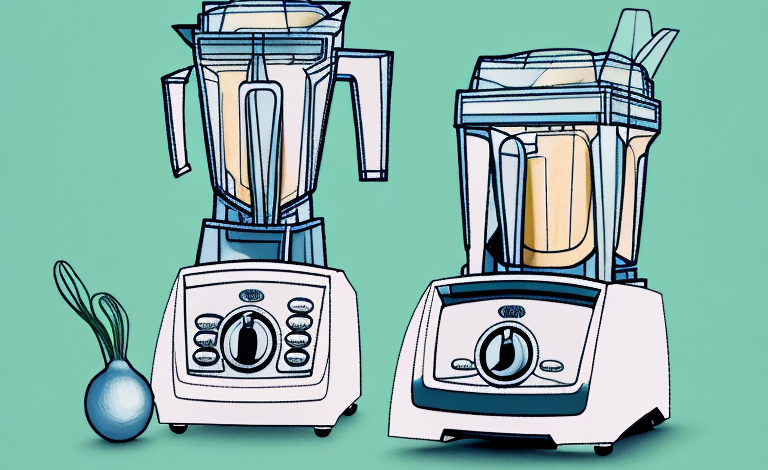If you own a Vitamix, then you know how powerful and versatile these blenders can be. They’re a kitchen staple for many people who love to cook and prepare healthy meals. But, like any kitchen appliance, they require regular maintenance to keep them running smoothly and efficiently. In this article, we’ll cover everything you need to know about maintaining your Vitamix, from cleaning the blades to troubleshooting common problems, so that you can enjoy delicious smoothies and soups for years to come.
Why is it important to maintain your Vitamix?
Maintaining your Vitamix is essential for a few reasons. Firstly, regular maintenance ensures that your blender is operating at its highest level of performance. When blades get dull, or the motor starts to wear out, your Vitamix won’t work as well, which can be frustrating when you’re trying to blend tough ingredients. Secondly, keeping your Vitamix clean can help prevent the growth of harmful bacteria and mold, which can cause health issues or a foul smell in your blender. Finally, maintaining your blender can help you save money in the long run by preventing breakdowns and reducing the frequency of replacement parts or repairs.
One additional reason to maintain your Vitamix is that it can help extend the lifespan of your blender. By regularly cleaning and replacing parts as needed, you can prevent wear and tear on your machine, which can ultimately lead to a longer lifespan. This means that you’ll be able to enjoy your Vitamix for years to come, without having to worry about replacing it anytime soon.
What are the components of a Vitamix that need regular maintenance?
Several components of your Vitamix require regular maintenance to keep your blender in good shape. These include the pitcher, lid, blades, tamper, and motor base. Each component of your Vitamix requires different cleaning techniques to be maintained correctly. Neglecting any of these components can lead to a sloppy and ineffective blending experience.
The pitcher of your Vitamix should be cleaned after every use. To clean the pitcher, fill it halfway with warm water and add a drop of dish soap. Run the blender on high for 30 seconds, then rinse the pitcher thoroughly with warm water and let it air dry. If you notice any stains or discoloration on the pitcher, you can use a mixture of baking soda and water to scrub it clean.
The blades of your Vitamix should also be cleaned regularly to ensure optimal performance. To clean the blades, fill the pitcher halfway with warm water and add a drop of dish soap. Run the blender on high for 30 seconds, then rinse the blades thoroughly with warm water and let them air dry. If you notice any buildup on the blades, you can use a soft-bristled brush to gently scrub them clean.
How often should you clean and maintain your Vitamix?
After each use, it’s essential to give the pitcher and lid of your Vitamix a quick rinse with warm water and dish soap. But a deeper clean should be done every few months or whenever you see any buildup. The blade assembly and tamper should also be cleaned after each use. The motor base and power cord should be cleaned occasionally to prevent dirt and debris from clogging the motor vent. It’s wise to check your manufacturer’s instructions for specific cleaning procedures and timings.
It’s important to note that the frequency of cleaning and maintenance may vary depending on how often you use your Vitamix. If you use it daily or multiple times a day, you may need to clean it more frequently than someone who only uses it occasionally. Additionally, if you use your Vitamix to blend tough ingredients like nuts or seeds, you may need to clean it more often to prevent buildup.
When cleaning your Vitamix, it’s best to use a soft sponge or cloth to avoid scratching the pitcher or blade assembly. Avoid using abrasive cleaners or scrubbers, as they can damage the surface of your Vitamix. If you notice any damage or wear and tear on your Vitamix, it’s important to address it promptly to prevent further damage and ensure the longevity of your machine.
What tools do you need for cleaning your Vitamix?
To clean your Vitamix, you will need a few tools, including a soft cleaning brush, a non-abrasive sponge or cloth, a small cleaning brush, and soap or vinegar. The cleaning brush is designed specifically for cleaning the blades and tamper of your Vitamix. It would be best if you had a non-abrasive sponge or cloth to clean the pitcher and other plastic parts. Soap or vinegar can be used to help deep clean your Vitamix.
When cleaning your Vitamix, it is important to note that you should never use abrasive materials such as steel wool or harsh chemicals like bleach. These can damage the plastic and affect the performance of your blender. Additionally, it is recommended to clean your Vitamix after each use to prevent any buildup of food particles or residue.
If you find that your Vitamix has developed a stubborn stain or odor, you can try using a mixture of baking soda and water to help remove it. Simply apply the paste to the affected area and let it sit for a few minutes before rinsing it off with water. This can be a helpful solution for those tough-to-clean spots.
How to disassemble and clean the blades of your Vitamix?
Disassembling the blades of your Vitamix can seem daunting, but it’s not that difficult. Start by unplugging your blender and then removing the pitcher from the base. Turn the pitcher upside down, and then twist the blade assembly to the left to unlock it. The blades are sharp, so be cautious when handling them. Use the cleaning brush to scrub the blades and remove any built-up debris. Avoid using harsh cleaners or the dishwasher, as it may dull your blades’ edges. Once you’ve cleaned the blades, reassemble them by aligning the arrow and aligning the tabs. Twist to lock the blade assembly to secure it in place.
It’s important to clean your Vitamix blades regularly to ensure that they continue to function properly. If you notice that your blender is not blending as well as it used to, it may be time to clean the blades. You can also prevent build-up by rinsing the blades immediately after use and allowing them to air dry before reassembling.
If you’re having trouble removing the blade assembly, try using a rubber jar opener to provide extra grip. You can also use a small amount of vegetable oil to lubricate the threads and make it easier to twist off. Remember to always handle the blades with care and keep them out of reach of children.
Tips for cleaning the pitcher and lid of your Vitamix
Cleaning the pitcher and lid of your Vitamix is essential to keep it in a good working state. It would help if you started by rinsing the pitcher and lid with warm water after each use. For deeper cleaning, fill the pitcher halfway with warm water and one or two drops of soap. Run your Vitamix on the lowest setting for about thirty seconds, then empty the soap solution and rinse with water.
Another tip for cleaning your Vitamix pitcher and lid is to use a mixture of baking soda and water. This mixture can help remove tough stains and odors from your pitcher and lid. Simply mix one tablespoon of baking soda with one cup of warm water and pour it into the pitcher. Run your Vitamix on the lowest setting for about thirty seconds, then empty the solution and rinse with water.
It’s also important to clean the base of your Vitamix regularly. To do this, unplug your Vitamix and wipe the base with a damp cloth. Avoid using abrasive cleaners or scrubbers that can damage the surface of your Vitamix. Keeping the base clean can help prevent dust and debris from getting inside and affecting the performance of your Vitamix.
How to deep-clean your Vitamix using vinegar or baking soda
Vinegar or baking soda can be used if you want to deep-clean your Vitamix. To clean with vinegar, mix equal parts warm water and white vinegar in your Vitamix. Run your Vitamix on high for a few minutes, then pour out the solution and rinse with plain water. For baking soda, mix a tablespoon of baking soda and some water in the pitcher of your Vitamix. Run the blender on high for about thirty seconds, then empty the contents and rinse with water.
The dos and don’ts of cleaning your Vitamix
When cleaning your Vitamix, there are a few dos and don’ts to keep in mind. Do use soap and warm water to clean the pitcher and lid. Do sanitize your Vitamix with vinegar or baking soda if you notice any buildup. Do take caution when cleaning the blades, as they are sharp. Don’t use abrasive cleaners or scrubbers that will scratch or dull the plastic. Don’t immerse the motor base in water or put it in the dishwasher.
How to troubleshoot common problems with your Vitamix
Sometimes, even with the best of maintenance, things can go wrong with your Vitamix. The most common issue is that your blender stops working or doesn’t blend correctly. To troubleshoot this issue, first ensure that all the components are properly assembled. If this is not the case, then try resetting the blender by switching on and off at the power outlet. If the issue persists, contact your Vitamix dealer or manufacturer.
How to store your Vitamix properly to prevent damage
When not in use, store your Vitamix properly to prevent damage. First, ensure that all the components are clean and dry before storing. Store the motor base on a level surface, and cover it if possible to prevent dust and debris from settling on it. Store the pitcher and lid separately, and use a shelf or cabinet that is sturdy and secure.
Why should you use only recommended cleaning products for your Vitamix?
Using only the recommended cleaning products for your Vitamix is essential to prevent damage or malfunction. Harsh chemicals or abrasive cleaners can scratch or dull the plastic, and even cause parts to warp or crack. This may lead to leaks or motor malfunction. Always refer to your Vitamix manufacturer’s instructions for cleaning products and techniques.
How to maintain the warranty on your Vitamix by following proper cleaning procedures
By following proper cleaning procedures, you can maintain the warranty on your Vitamix. If you have any issues with your blender during the warranty period, it’s essential to follow the manufacturer’s repair or replacement recommendations. Improper cleaning may void the warranty or cause other issues down the line, which may lead to extra expenses. Therefore, always follow your Vitamix’s recommended cleaning procedures to maintain the warranty.
In conclusion, maintaining your Vitamix requires a bit of effort, but it’s worth it to preserve your blender’s performance and longevity. By following these cleaning tips and techniques, you can ensure that your Vitamix is always ready whenever you need it.



